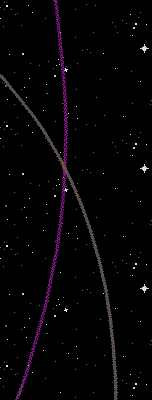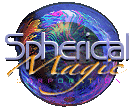 |
STARDUST™, the first NASA spacecraft designed to physically encounter an object of study and survive, dives into the coma of This virtual reality animation is based upon the three STARDUST™ Panoramas, commissioned by the Jet Propulsion Laboratory at CalTech in Pasadena, California, that tell the story of the STARDUST™ Mission. The animation requires QuickTime 3 or higher. If you do not have QuickTime 3 installed, a QuickTime 2 version will be supplied. If you prefer, individual QuickTime 2 animations are also provided. Some dialup accelerators may prevent complete loading of QuickTime movies. The orbit trajectory map to the left illustrates the spacecraft's course as it crosses the path of Comet Wild-2. Once inside the comet coma, you will see the spacecraft at closest approach to the nucleus, gathering samples of cometary material with Aerogel contained in the extended paddle shaped sample collector at the rear of the craft. The Whipple Shields on the leading edge absorb and deflect potentially dangerous ice and rock particles, protecting the spacecraft throughout its historic journey.
|
An Element of  |
Continuing on outside the coma, the spacecraft's protective shields exhibit the effects of the collisions encoutered as we sped through at 13,000 MPH. From here we travel back toward Earth, carrying our precious cargo. The return capsule will be spun up, released, re-enter our atmosphere and then parachute safely into the desert to be retrieved for analysis of the first comet samples returned to Earth.
Learn More... Clues From Comets Exploring Our Solar System's Origins A presentation by Knight Ridder/Tribune
Learn more about the STARDUST™ mission and view the three major panoramas used to create this animation. |
| Correspondence is welcomed. Images & Text Copyright © 1976-2024 B.E.Johnson, All Rights Reserved STARDUST™ is a trademark of The California Institute of Technology. |